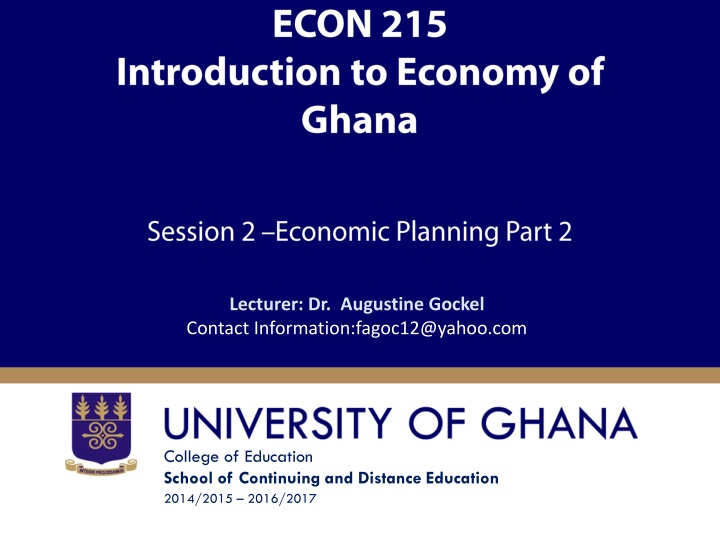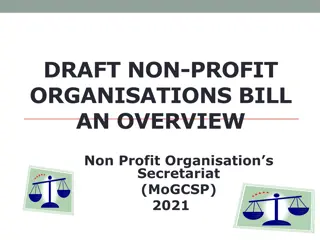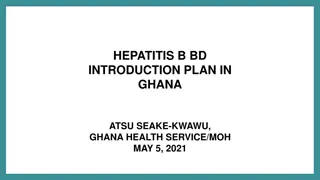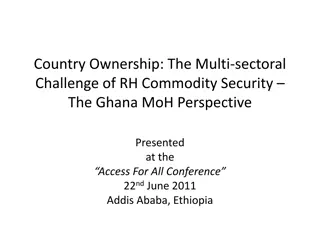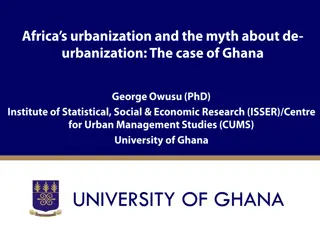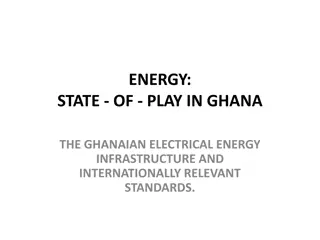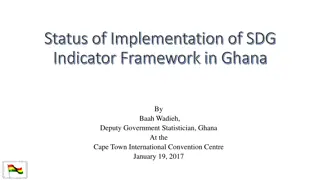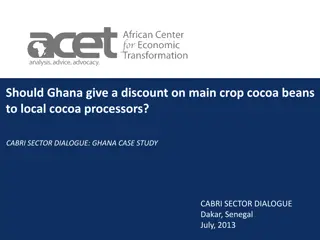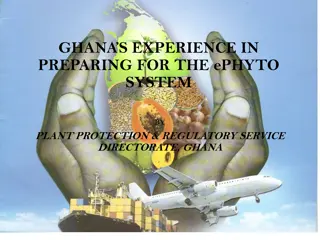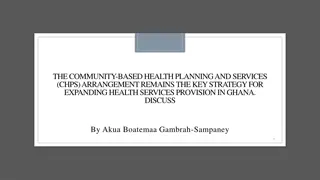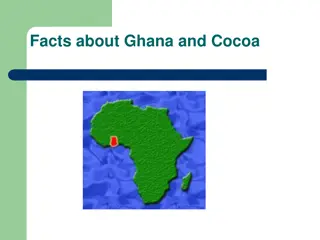Economic Planning in Ghana: Vision 2020 and Beyond
This session led by Dr. Augustine Gockel discusses the economic planning strategies in Ghana, focusing on the Consolidated Programmes for Economic and Social Development. It delves into the Vision 2020 objectives, including social conditions improvement, macroeconomic stabilization, agricultural development, technology utilization, and infrastructure enhancement. Explore the reasons for plan failure and gain a deeper understanding of economic planning in Ghana.
Download Presentation

Please find below an Image/Link to download the presentation.
The content on the website is provided AS IS for your information and personal use only. It may not be sold, licensed, or shared on other websites without obtaining consent from the author.If you encounter any issues during the download, it is possible that the publisher has removed the file from their server.
You are allowed to download the files provided on this website for personal or commercial use, subject to the condition that they are used lawfully. All files are the property of their respective owners.
The content on the website is provided AS IS for your information and personal use only. It may not be sold, licensed, or shared on other websites without obtaining consent from the author.
E N D
Presentation Transcript
Lecturer: Dr. Augustine Gockel Contact Information:fagoc12@yahoo.com College of Education School of Continuing and Distance Education 2014/2015 2016/2017
Session Overview Session Overview: This session continues with the discussions on economic planning by looking at a unique set of policies christened the Consolidated Programmes For Economic And Social Development Of Ghana . The session concludes by considering the reasons for the failure of economic plans. Goals/ Objectives: At the end of the session, the student will Be able to acquire a deeper appreciation of economic planning in Ghana Understand the reasons for the failure of economic plans Slide 2
Session Outline The key topics to be covered in the session are as follows: Topic One: Consolidated Programmes For Economic And Social Development Of Ghana Topic Two: Reasons for Plan Failure Slide 3
Reading List Refer to students to relevant text/chapter or reading materials you will make available on Sakai Slide 4
Topic One CONSOLIDATED PROGRAMME FOR ECONOMIC AND SOCIAL DEVELOPMENT OF GHANA Slide 5
Vision 2020 (1996-2020) It must be noted that VISION 2020 is not necessary(necessarily) a development plan. It is a policy document introduced by the NDC regime to bring Ghana to a middle-income status by the year 2020. The implementation of the policy framework was essentially broken down into phases i.e. the consolidation period or the medium term (1996-2000) and long term period (2001- 2020). Consolidation period (1996-2000) This period was supposed to consolidate the gains made from the last decade (1986-1995) and also to lay strong foundation for accelerated growth and development in the subsequent two decades. Hence this medium-term coordinated programme of policies represented the first step towards the achievement of the goals in VISION 2020. Slide 6
Vision 2020 Contd The document sought among other things to achieve the following as its medium-term objectives: i. Improve upon the level of social conditions in terms of education, health and other social amenities in the economy. ii. To stabilize the macroeconomic environment in terms of improving upon the exchange rate and the level of inflation. Also related to this was the objective of increasing the country(country s) annual GDP iii. To improve upon the production, processing and marketing of agricultural products iv. To fully utilize the modern concept of science and technology which have become the driving force of modern economies v. To improve upon the existing level of infrastructure, environment and public administration. Slide 7
VISION 2020 Contd vi. To ensure that small and medium-sized towns adequately fulfill their role as service centers for rural hinterland, and that the process of urbanization will contribute positively to economic development vii. To create the enabling environment in which all sectors of the economy would contribute to sustained and accelerated growth rate in social and economic development. viii. By the end of the consolidation period (i.e within the first five years, 1995-2000), VISION 2020 had become a total fiasco; all the targets set could not be achieved. Slide 8
Vision 2020 Contd The long term period had the following objectives: The long-term period (2001-2020) i. Reduction of population growth rate to 2% by 2020 in order to improve upon human development. ii. To create the necessary environment to promote investment thereby enhancing economic growth targeted at over 8% by 2020 Reduce disparities between the rural and the urban centers, in order to improve the live(lives) of the rural folks iii. iv. To ensure that small and medium-sized towns adequately fulfill their role as service centers for rural hinterland, and that the process of urbanization will contribute positively to economic development Slide 9
Vision 2020 Contd iv. To create the enabling environment in which all sectors of the economy would contribute to sustained and accelerated growth rate in social and economic development. v. By the end of the consolidation period (i.e within the first five years, 1995-2000), VISION 2020 had become a total fiasco; all the targets set could not be achieved. Slide 10
The Coordinated Programme for Economic and Social Development of Ghana (2003-2012) Like the defunct vision 2020, the coordinated programme for Economic and Social Development of Ghana (2003-2012) sometimes referred to, as the VISION 2012 was not strictly a development plan. It was a kind of policy framework designed by the NPP administration to make Ghana a middle-income country by the year 2012. A significant milestone along the path to becoming a middle- income country was obtaining a per capita income of US$1000 within the time period 2003-2012. To make this feat achievable, the first benchmark is to double our current national income within a decade Slide 11
The Coordinated Programme for Economic and Social Development of Ghana (2003-2012) Cont d There are two sets of development objectives enshrined in the document: i. Laying down the foundations of accelerated development ii. The long-term programmes that will catapult the economy into a higher trajectory, thus propelling the economy into a sustained accelerated growth path. Foundation of the Plan In the national quest for accelerated growth, there is the need to build a strong and unshakable socio-economic foundation. Slide 12
The Coordinated Programme for Economic and Social Development of Ghana (2003-2012) Cont d The foundation building strategies and objectives are also contained in the Ghana Poverty Reduction Strategy (GPRS) as the Medium- Term Strategies include: i. Enhanced Infrastructure ii. Rural Development based on the modernization of agriculture iii. Enhanced Social Services iv. Good Governance v. Private Sector Development Slide 13
The Coordinated Programme for Economic and Social Development of Ghana (2010-2016) The development plan aimed to put in place strategies over a ten-year period to rapidly transform the structure of the Ghanaian economy while accelerating poverty reduction by achieving a poverty incidence of less than 8 percent in 2015. More importantly, the development plan sought to integrate and harmonise otherwise disparate development agenda and sectoral development plans into one development plan. In particularly, the Growth and Poverty Reduction Strategy (GPRS II) was anchored in the 10-year development plan. The GPRS II formed a medium term plan of the 10-year development plan. i. ii. iii. iv. The 10-year development plan (2006-2015) focused on four key areas; Industrial development for a small open economy Modernizing agriculture Human capital development for structural transformation of Ghana s economy Human settlement for a changing economy. Slide 14
The Coordinated Programme for Economic and Social Development of Ghana (2010-2016) This Programme was a strategic blueprint for directing national priorities in the medium-term and for providing a framework for channelling national aspirations towards accelerated industrial development. It therefore was to guide the execution of development policy and related activities at all levels of the governance structure. The immediate objective was to bring Ghana closer to the long-term vision of a society in which: We can expect that extreme forms of deprivation, such as hunger, homelessness, and poverty, shall be a thing of the past; Economic growth will be environmentally sensitive and public policy will ensure that it is equitable across sectors, administrative regions, and socio-economic groups; The economy is driven by industrial production with full participation of Ghanaians in a stable macroeconomic environment Healthcare is available and affordable, and education prepares people for purposeful life; i. ii. iii. iv. Slide 15
The Coordinated Programme for Economic and Social Development of Ghana (2010-2016) Cont d iv. quality jobs are created for a well trained and employable youth v. Science, technology and innovation underline the solution of the nation s problems to speed up advancement; and vi. Ghanaians, regardless of socio-economic status, gender, belief or persuasion can participate in and equitably share the benefits of national progress. Slide 16
The Coordinated Programme for Economic and Social Development of Ghana (2014-2020) The Programme sets out the policies, programmes and strategies for achieving the socio-economic transformation of the country as envisaged in our Advancing the Better Ghana Agenda , which was out-doored in 2012. Over the medium-to-long term, average national income, which currently stands at US$1,550 (lower middle-income) is expected to increase to between US$7,500 and US$10,000 (upper middle income) in today s prices. As part of a broad strategy to diversify economic production and exports through increased value addition and the aggressive development of non- traditional products and markets the following will constitute the hallmarks of a transformed and resilient Ghanaian economy under this Programme: Slide 17
The Coordinated Programme for Economic and Social Development of Ghana (2014-2020) Cont d i. A modernised and highly productive agricultural sector with high value addition and backward and forward linkages to science, technology, industry and local and international markets; A dynamic, efficient and competitive private sector, with special emphasis on small-and medium enterprises (SMEs); Well-developed infrastructure with improved transportation, including road, rail and air travel as well as logistics facilities across the country and the region; reliable energy and water supply; and ICT networks, among others; A proactive government-private sector relationship that creates opportunities for Ghanaian businesses both at home and abroad; A high degree of industrial peace through the effective use of existing tripartite arrangements between labour, employers and government; A light-manufacturing sector that lays the groundwork for a broader and globally competitive industrial sector in the long term; A 21st labour force that is knowledgeable, highly skilled, healthy, and globally competitive; A responsible and responsive citizenry who are disciplined, hardworking and dedicated to their broad civic responsibilities. ii. iii. iv. v. vi. vii. viii. Slide 18
Topic Two REASONS FOR PLAN FAILURE Slide 19
Deficiency in Plan and Their Implementation Some of the plans are over-ambitious, for example, the 7- year Development Plan by Nkrumah was to establish 600 industries to produce 100 different products and achieve a 10% growth rate by 1970 among others. Some plans have too many objectives to be accomplished simultaneously as a result it creates wide disparity between implementation and formulation. Some development plans are merely formulated without being implemented for reasons expedient to the politicians and other stakeholders. Slide 20
Insufficiency and Unreliable data The usefulness of a development plan substantially depends on the availability, quality and reliability of the statistical data on which it is based. When these data are weak, unreliable or nonexistent, the accuracy and internal consistency of nationwide qualitative plans (projection) are greatly undermined. Attempts to formulate and implement detailed economic plans in most LDCs have often been frustrated by inadequate supply of qualified economists, statisticians and other planning personnel. Slide 21
Unanticipated economic and political disturbances Most LDCs are open economies with considerable dependence on volatility of international trade, aid and foreign direct investments. The precariousness of such external flows makes it difficult to undertake both short term and long term forecast. In addition, oil price shocks such as that of 1974, 1979 and 1990 obviously undermined most LDCs development plans. On the political side, the rapidity with which governments after governments are overthrown through the gun in some LDCs have been the bane of development planning. In Ghana for example, there have been several attempted coup d etats interlaced with successful coup d etats Slide 22
Institutional Weakness The issue of the institutional weakness encompasses the separation of the planning agency from day-to-day decision making machinery of government . Moreover, planners, administrators and political leaders fail to engage in continuous dialogue and internal communication about goals and strategies. Institutional weakness is also manifested in the international transfer of institutional planning practices and organisational arrangements that may be inappropriate to local conditions. For instance, Nkrumah s 7-year Development Plan took a lot of inspiration from the 7-year Soviet Plan without taking cognisance of the distinct features of the Ghanaian economy. Additionally, there is prevalence of incompetent and unqualified civil servants; cumbersome bureaucratic procedures; excesses(excessive) caution and resistance to innovation and change and inter-ministerial personal and departmental rivalries (finance ministries and planning agencies are often conflicting) among others Slide 23
Lack of political will Poor plan performance and the wide disparity between plan formulation and plan implementation are attributable to the lack of commitment and political will on the part of many developing country leaders and other influential decision makers. Governments sometimes fail to implement laudable development plans because they may be challenged by powerful elites and vested-interest groups who are often egoistic. The onus lies on the government to convince such groups that such projects when implement(implemented) will serve the long-run interest of all citizens (though some of them may suffer short-term losses) otherwise they will be met with staunch resistance, frustration and growing internal conflict. Slide 24
References Slide 25
